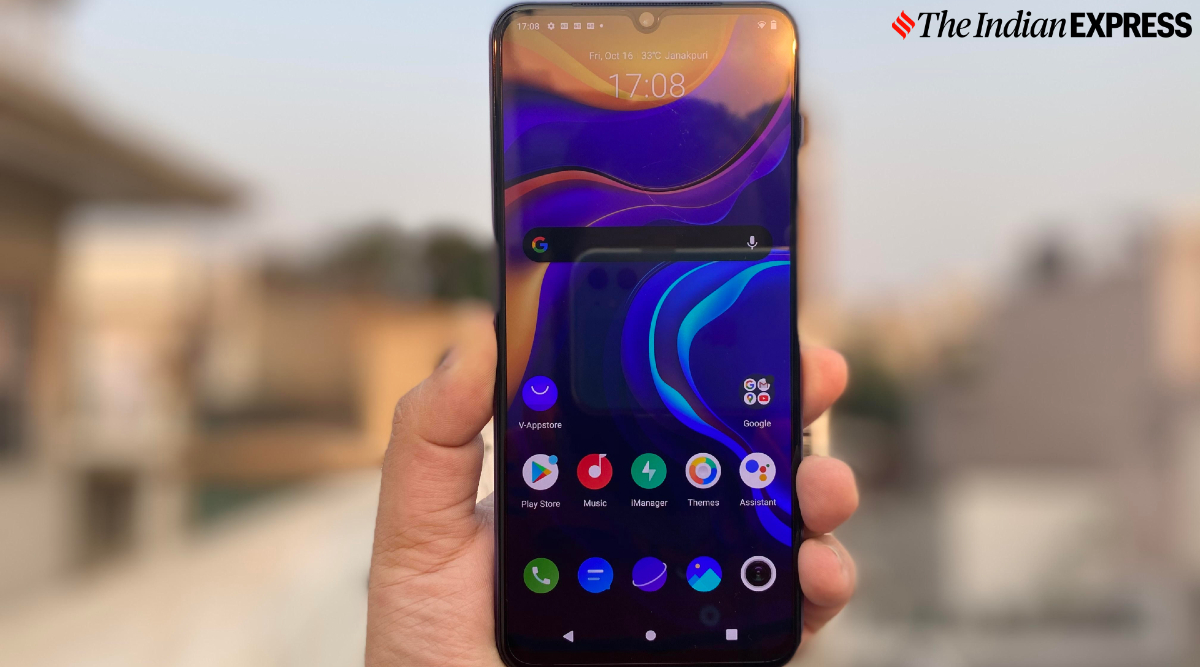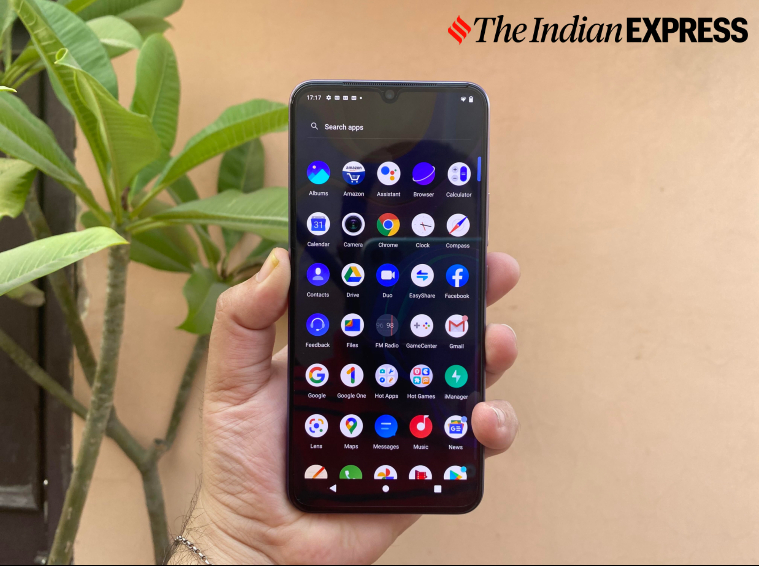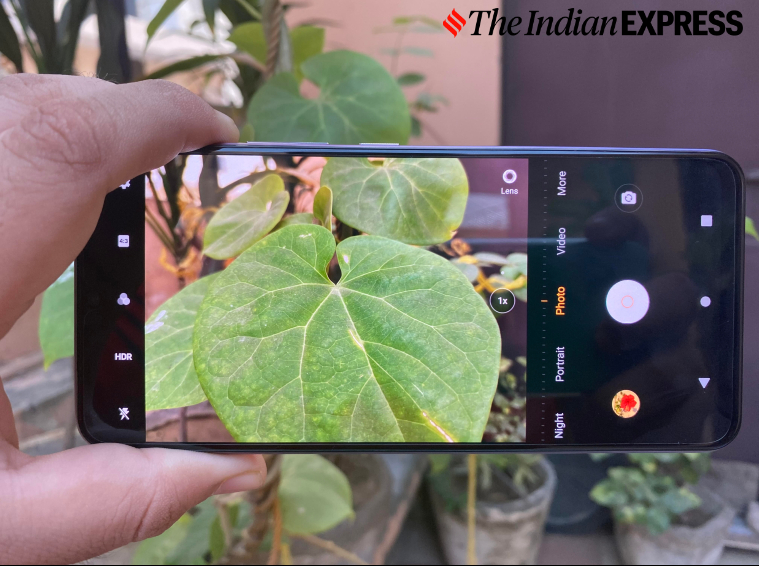 At 7.38mm thick, the V20 is one of the slimmest smartphones you can find in this price segment. (Image credit: Anuj Bhatia/Indian Express)
At 7.38mm thick, the V20 is one of the slimmest smartphones you can find in this price segment. (Image credit: Anuj Bhatia/Indian Express)In a hyperactive smartphone market like India, it is not easy to stand out from the competition unless you give consumers the right features they want to use in a phone. And if a phone falls in the mid-range segment, the bigger challenge is maintaining a balance between price and performance. With its latest V20, Vivo has tried to put together a well-balanced smartphone that meets the needs of average consumers. But here’s the question: How different is the Vivo V20 experience and who should buy this? I tested the V20 for a week to find out whether Vivo’s newest mid-range smartphone is worth your money and time.
Vivo V20 price in India: Rs 24,990
Vivo V20 review: Design and build
For the price, I think the Vivo V20 does look premium, with aluminum sides and a glass back. At 7.38mm thick, the V20 is one of the slimmest smartphones you can find in this price segment. The 6.44-inch V20 is not as small as the Pixel 4a, but it’s nowhere close to the size of the iPhone 11 Pro. I found the V20 easy to hold and use with one hand.
Like newer phones of today, Vivo V20 follows the near edge-to-edge look, though it comes with a waterdrop-style notch that feels a bit dated in comparison to the punch-hole camera cutout. Flip the phone over and you will see a frosted glass back. My review unit had this sunset melody colour variant which makes the phone a bit more interesting. The rectangular camera module in the top left corner houses three lenses. I was glad to see that there is a 3.5mm headphone jack on the V20, though it lacks waterproofing and wireless charging. But you won’t miss these features, anyway.
 My review unit had this sunset melody colour variant which makes the phone a bit more interesting. (Image credit: Anuj Bhatia/Indian Express)
My review unit had this sunset melody colour variant which makes the phone a bit more interesting. (Image credit: Anuj Bhatia/Indian Express)
Vivo V20 review: Display and speakers
The V20 has a large 6.44-inch AMOLED display that touts a Full HD+ resolution and is HDR 10 compliant. The size of the display is right, but now there are many phones available in the mid-range segment that offer a bigger display. The Galaxy M51, for example, has a 6.7-inch FHD+ AMOLED display.
I personally have no issues with the V20’s display. The colours are punchy and the screen also gets plenty bright to read texts and web pages outdoors, though I found the 6.44-inch display a bit reflective. The screen, however, doesn’t support a 90Hz refresh rate as the OnePlus Nord.
The V20 has a mono speaker as opposed to stereo speakers, but they get loud and they sound above average. The phone uses an in-display fingerprint scanner which thankfully didn’t disappoint. It’s fast and unlocks the phone quickly.
 The V20 is one of the first new phones to launch with Android 11 out of the box. (Image credit: Anuj Bhatia/Indian Express)
The V20 is one of the first new phones to launch with Android 11 out of the box. (Image credit: Anuj Bhatia/Indian Express)
Vivo V20 review: Performance and battery
The V20 is a mid-range phone at heart, and it shows. It has Qualcomm’s Snapdragon 720G processor paired with 8GB RAM and 256GB expandable storage. Although the chipset isn’t as powerful as the Snapdragon 765G, it’s still fast. But I did witness minor lags when opening web pages or when running graphics-intensive games. In day-to-day use, I have had no problems with the phone.
I was happy with the battery life on the V20. The 4000mAh battery lasted a full day when connecting the phone to Wi-Fi (Since I am working from home I have turned off 4G on the phone). That was when I primarily used the phone for watching YouTube videos, browsing the internet, playing games, listening to music on Spotify, and checking emails. I think the battery should last a bit longer under normal use. The phone also ships with a 33W charger that fills the battery from zero to 100 per cent in less than an hour.
Another highlight of the V20 is its software. It is one of the first new phones to launch with Android 11 out of the box. The best part is that Vivo has overhauled the user interface with minimal preloaded apps from Vivo and third-party developers.
Specifications
Display: 6.44-inch FHD+ AMOLED, HDR10 compliant
Processor: Qualcomm Snapdragon 720G
Storage/RAM: 8GB RAM, 128GB/256GB storage, microSD support (up to 1TB)
Software: Funtouch OS based on Android 11
Battery: 4000mAh, 33W fast charging support
Camera: Triple rear-cameras (64MP+8MP+2MP), 44MP Eye Autofocus selfie camera
Colour options: Sunset Melody, Midnight Jazz
 In daylight, you get a surprisingly natural shot, with nice colours and good contrast. (Image credit: Anuj Bhatia/Indian Express)
In daylight, you get a surprisingly natural shot, with nice colours and good contrast. (Image credit: Anuj Bhatia/Indian Express)
Vivo V20 review: Camera
The V20 has three cameras on the back. The setup consists of a 64 MP main sensor, an 8MP 120-degree wide-angle camera, a 2MP monochrome sensor. Then there is a camera on the front: a 44MP “Eye Autofocus” selfie shooter.
In daylight, you get a surprisingly natural shot, with nice colours, good contrast, and a well-balanced exposure. But I struggled to get sharp images using the same 64MP camera indoors. The other two cameras are okay – not too great, not too bad. Due to the lack of the depth-sensing camera, I got lousy portrait shots. Given the choice, I would choose the depth-sensing camera over the mono lens any day. Low-light performance is acceptable but nothing amazing as such.
Check out some of the pictures I clicked using the Vivo V20.
 (Image credit: Anuj Bhatia/Indian Express)
(Image credit: Anuj Bhatia/Indian Express)
 (Image credit: Anuj Bhatia/Indian Express)
(Image credit: Anuj Bhatia/Indian Express)
 (Image credit: Anuj Bhatia/Indian Express)
(Image credit: Anuj Bhatia/Indian Express)
 (Image credit: Anuj Bhatia/Indian Express)
(Image credit: Anuj Bhatia/Indian Express)
Perhaps the headline feature of the V20 is its 44MP camera with an Eye Autofocus technique that you will only find in DSLRs and mirrorless cameras. It’s a hit and miss feature, and I honestly don’t think the Eye Autofocus technology makes a huge difference to average consumers other than Vloggers. Otherwise, the front-facing camera is capable of capturing terrific detail in good lighting. It can also do slow-motion selfies as well as record selfie videos in 4K.
Vivo V20 review: Should you buy it?
The Vivo V20 is an impressive mid-range smartphone, but it’s not perfect. The problem with the V20 is that Vivo has played it safe and there is not much dramatically different from its predecessors. That’s not a bad thing necessarily, given the high level of competition in the mid-range segment, Vivo V20 does not fully shine. With smartphones like the Galaxy M51 and Pixel 4a priced under Rs 30,000, Vivo needs to think differently to counter the stiff competition.
📣 The Indian Express is now on Telegram. Click here to join our channel (@indianexpress) and stay updated with the latest headlines
For all the latest Technology News, download Indian Express App.


